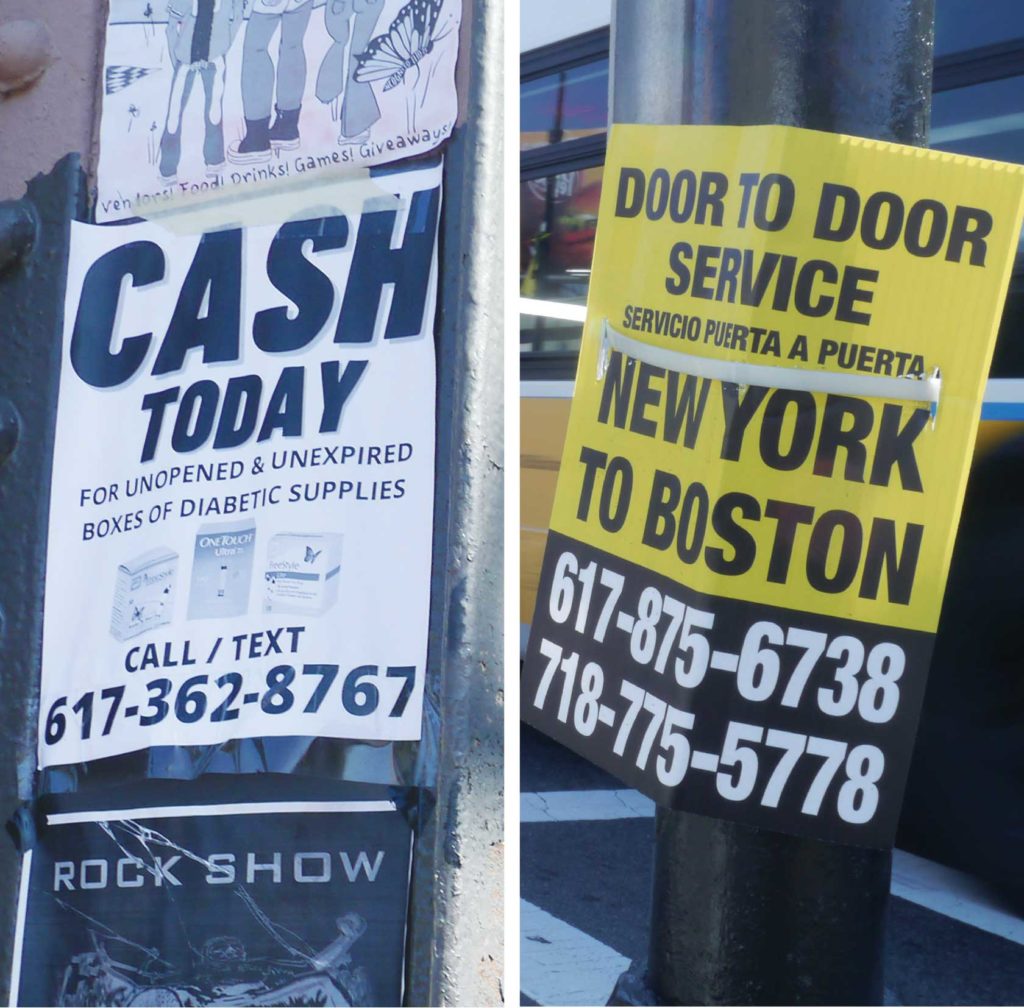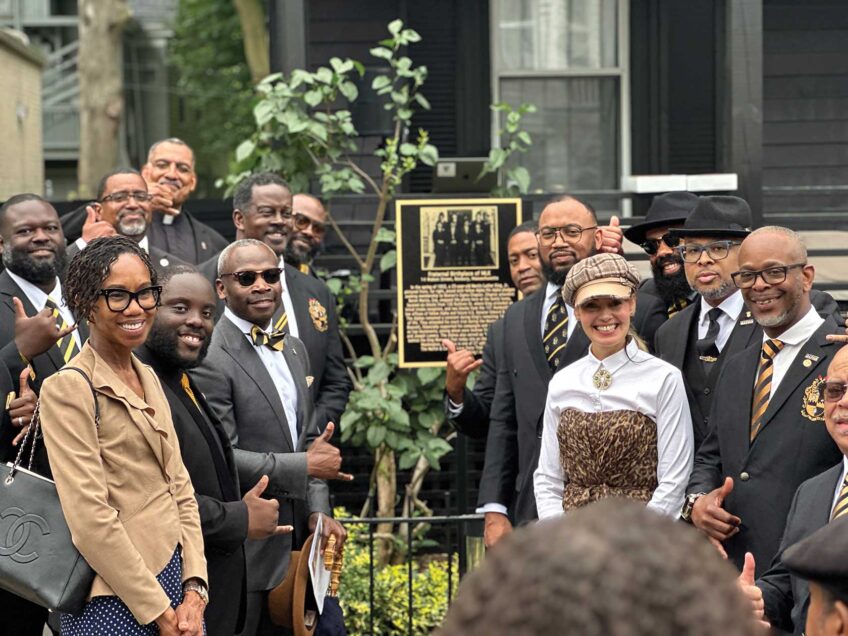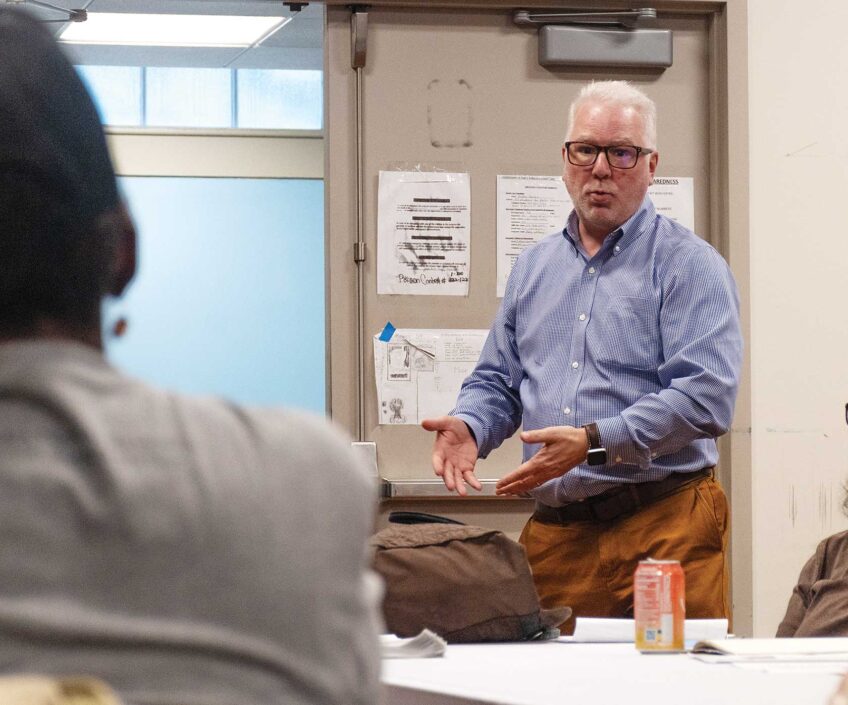
Hanging on utility poles and traffic signals and posted beside bus stops, corrugated plastic signs promote people willing to buy homes or diabetic test strips for cash and advertise local businesses. But these illegally posted signs are a point of concern for leaders of local neighborhood associations.
“They’re not very attractive,” said Lorraine Payne Wheeler, a founder of Roxbury Path Forward and a candidate for the Boston City Council District 7 seat. “They’re numerous. They’re as unattractive as any litter you see in the neighborhood.”
Prohibited by the City of Boston Municipal Code, these signs can create litter if torn down in storms, according to a representative from the city of Boston’s Department of Public Works.

Much of the illegally-posted advertising revolves around the black market in the resale of diabetic supplies. BANNER PHOTO
But even while hanging up, the signs are an “eyesore,” said Louis Elisa, head of the Garrison Trotter Neighborhood Association in Roxbury.
“Who wants to be looking at signs when they’re at the light stopped — ‘We buy some testing materials,’ ‘We buy this and that,’ you know? So, I have real concerns.”
Lavette Coney, president of the Mount Pleasant, Forest and Vine Neighborhood Association, worries that the signs have deeper roots in institutional racism.
“I was more concerned with the [signs] for housing, so ‘We want to buy your house no matter how your house looks,’” Coney said. “And it’s like, OK, we know that’s a pathway to intergenerational wealth, but yet, you want to come into these communities.”
For her, being able to pass on her house to her children is a priority.
“[Growing up,] I always stayed in rentals and affordable housing,” Coney said. “So, when I was in college, I saw all of these white students who were like ‘Oh, my parents are giving me money to buy a house.’ I didn’t have that. So, my house is for my kids.”
Residents can alert the city of illegally hung signs and ask that they be taken down by submitting a 311 request. The 311 system is designed to help Bostonians access non-emergency services and information.
According to data released by the city, in 2021, 48 requests have been made so far to have signs removed. Over the past five years, 729 have been submitted and of those, 694 have been marked as closed. According to a representative from the Department of Public Works, code enforcement officers are supposed to close a request when the sign is removed.
But leaders of the local neighborhood associations find the removal system less than satisfying.
“When we called 311 to let them know, they said ‘OK, we’ll get to it,’ and we asked them to call Public Works or Code Enforcement or environment, and then we come back and we still see them,” said Elisa, who has reached the point of taking some signs down himself.
Local residents said they have noticed more signs in neighborhoods that are predominantly of color or predominantly lower income.
“I’ve never seen anything in West Roxbury; I’ve never seen anything in Wellesley; I’ve never seen anything in Beacon Hill, you know, a private company putting up a sign saying, ‘We buy ugly homes’ or ‘We buy test strips’ or ‘We buy formula,’” Elisa said. “Not that it’s not there, but you know, traveling, driving, riding the T and the buses throughout the city, I know distinctly, based on what’s on the public utility poles when I’ve traveled outside of low-income and working-class community to the … higher-income community.”
This disparity is at the crux of Coney’s concerns about institutional racism fueling the placement of the signs.
“Why are they putting them only in the Black areas? You see what I’m saying?” Coney said. “If they were putting them in Newton, putting them in Brookline, it’d be a different story. But they don’t. Those signs don’t go up there. So, they’re only targeting people who have been marginalized.”
Data about the city’s 311 service requests do not reflect this divide. In the past year, by neighborhood, Back Bay has had the greatest number of 311 requests for sign removal per square mile, followed by Fenway-Kenmore and the North End. Roxbury was ninth, Dorchester was 12th, and Mattapan was 15th of 17.
However, the data set does not identify what sort of signs were hanging up. Nor does it take into account how comfortable residents of the neighborhood are with using the 311 system.
Coney said residents in her community are less likely to use the system. She tries to remind people at meetings of her neighborhood association to use 311 in the hopes that it will bring more attention to the area’s complaints.
“White neighborhoods — like South End — they use 311 to their advantage,” Coney said. “So, when they put a spotlight on things, things get taken care of, and if they use it consistently, they usually get some traction.”
She said she thinks there are two main reasons local residents are hesitant to use 311.
“Most people do not even know that there’s an app,” Coney said. “Two, they don’t want their name associated with whatever complaint they give. Some people who live in our community work for the city, and they don’t want to lose their job, so regardless of whether it is wrong or racist, they are not doing or saying anything.”
Heads of local neighborhood associations acknowledge that, especially amid the pandemic, there are many big issues that require attention from the City of Boston, but for them, these signs remain a concern.
“I mean, there’s so much that goes on in the city, I don’t think it’s the most pressing problem, but it is an issue,” Payne Wheeler said. “It’s another way that urban spaces can be made less attractive than they need to be.”






